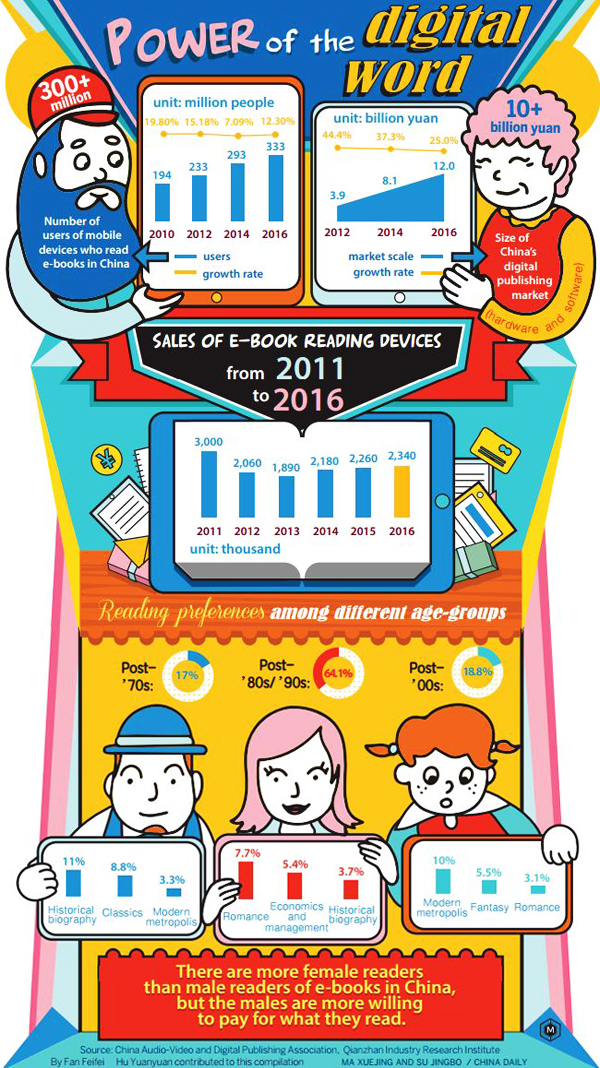Digital page turner
 |
|
Passengers at Jiangxi railway station read e-novels on their mobile phones while waiting for their train to arrive. [Photo by Hu Guolin/For China Daily] |
After online shopping, internet-based finance, mobile payments and bicycle-sharing, the digital dimension in China is taking in its sweep the world of books.
The publishing industry has gone digital in a big way, spawning a market comprising 300 million users of mobile devices who read electronic books in China.
The market, which has two key sections in hardware (reading devices) and software (e-books), reached about 12 billion yuan ($1.7 billion) in sales last year, up 25 percent year-on-year, according to a report by the China Audio-Video and Digital Publishing Association.
According to Shenzhen-based Qianzhan Industry Research Institute, a consulting agency, 3 million e-book reading devices were sold in 2011 in China. But the figure declined to 1.89 million units in 2013, only to rebound later, with annual growth rate exceeding 15 percent in 2014.
In 2015, 2.26 million e-book readers were sold; the figure rose to 2.34 million units last year.
What makes this trend striking is its divergence from the global pattern. Globally, sales of e-book readers peaked at 23.20 million units in 2011, but fell to 7.8 million units in 2015, according to market research firm Statista.
It estimates sales will likely continue to decline to about 7.1 million units in 2016 (data for last year is yet to be released).
With nearly an 8 percent share of the global market, China now trails only North America, the largest market for e-book readers in 2016 with a 68 percent share, and Europe (almost 14 percent share), according to market consultancy QYResearch.
Kindling sales
Just like in North America, where the e-book reader device market is dominated by manufacturers such as Amazon, Kobo and PocketBook (which account for a collective 75 percent of the market share), the e-reader market in China has a few big names.
Amazon with its Kindle range of devices is the common leader in both markets, but it is followed by iReader and newcomers such as e-commerce giant JD in China.
As the e-book reader pioneer, Amazon.com has created an ecosystem comprising users, digital versions of printed books, e-book stores online and e-book readers. Amazon said the China market is important for it.
Last month, it announced a strategic partnership with Migu Culture and Technology Group Co, a subsidiary of China Mobile Communications Corp, and also launched a feature-rich Kindle created exclusively for Chinese readers.
The device presents more than 460,000 Kindle e-books and over 400,000 online literature titles from Migu, one of the largest online literature platforms in China.
The made-for-China Kindle X Migu device retails for 658 yuan. "China has become the largest market in the world for Kindle and enjoys a very strong growth momentum," said Bruce Aitken, vice-president of Amazon China and general manager of Amazon Reading.
He said Chinese book-lovers are increasingly switching over to digital reading devices, and are willing to pay for e-books. This makes Amazon bullish on the future prospects of the digital publishing industry in China.
It has already introduced its full range of Kindle e-book readers in China, with the entry-level device priced 558 yuan.
Kindle has grown rapidly in the Chinese market. Compared to January 2013, Kindle offers 18 times more e-book options in China.
Aitken said Kindle has been in China for just four years and is still at the initial stage of development.
"We hope our e-book devices possess all of the advantages of traditional books. We will make efforts in R&D to improve battery life and make Kindle devices lighter and thinner in the future. We'll retain the advantages of e-books. For example, users can easily access any e-book at any time."
Amazon has also launched premium devices to attract high-end Chinese customers. In April 2016, the 2,399-yuan Kindle Oasis, the lightest and thinnest one in the Kindle family, was introduced in China concurrently with other markets in the world.
Amazon is not the only company betting big on e-book readers in China. Beijing-based iReader Technology Co Ltd released its latest e-book reader called the iReader Light in early September last year. The device weighs only 142 grams, and is priced 658 yuan.
Cheng Xiangjun, CEO of iReader Technology, said more than 100 million people across 150 countries use the iReader to read e-books each month.
Online shopping major JD.com Inc launched its JDRead last year. Priced 769 yuan, the JDRead device can access about 300,000 e-books.
The hardware segment has grown for sure, and the software segment, or e-books/content, appears set to follow suit.
"We find Chinese users refer to the dictionary a lot. Especially their use of the English dictionary is higher than in any other countries, so we specifically designed a function of tips about new words, and provide English-to-Chinese/English definition automatically for Chinese readers," Aitken said.
Amazon, he said, will launch more new functions over the next year.
Compared with printed books, the cost of e-books is very low. In fact, some of the e-books are free of charge or cost just a few dollars.
For instance, the printed version of The Shortest History of Europe, one of the top five bestsellers in 2016, is priced 25 yuan, while its e-book version retails for only 2.99 yuan.
To be sure, e-books account for only a small percent of the whole publishing industry. Sales of printed books reached 62.4 billion yuan in 2015, while revenue from e-books was 10.8 billion yuan, or 15 percent of the total, according to a book retail market report.
That suggests the potential for growth is immense. So, to make more e-books available to device buyers, Amazon introduced the Kindle Unlimited e-book monthly subscription service in February 2016 in China.
The service costs each user 12 yuan each month and allows users to access and read over 67,000 Chinese and foreign e-books on their devices.
Amazon has also forged partnerships with more than 660 publishers in China such as CITIC Press Group, Commercial Press, China Machine Press, Foreign Language Teaching and Research Press and Changjiang Children's Press.
More than hardware
There is more to the digital publishing industry in China than just hardware and software.
Elaine Chang, vice-president of Amazon, said male users outnumber female users in China, and all of them are younger.
In this respect, the China market is different from the US market where 70 percent of users are female and older.
A report from the China Audio-Video and Digital Publishing Association showed the post-'70s generation love historical biographies, while the post-'80s and post-'90s generation are willing to read romantic stories, while the post-'00 generation prefer modern metropolis stories.
Analysts said whether or not digital book sales would see significant growth depends on the range of content on offer in the market, not just the features of a device.
So, the emphasis should be as much on technology as nurturing more authors and original literature, they said.
Huang Guofeng, an analyst with Beijing-based consultancy Analysis, said, "China's digital book and e-reader market shows huge growth potential."





















